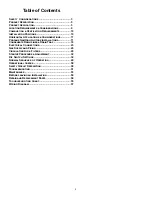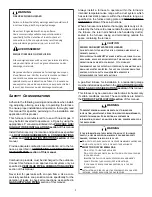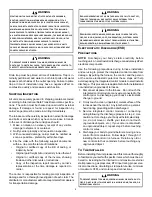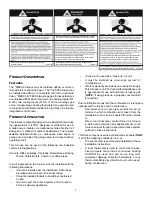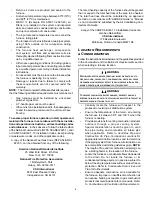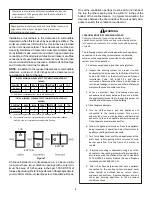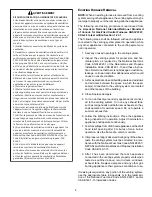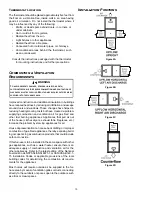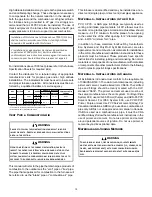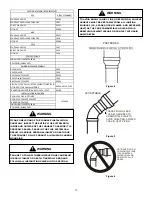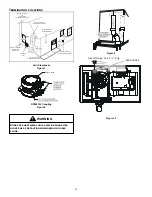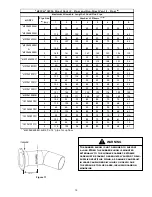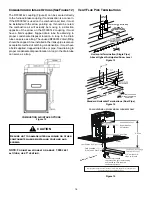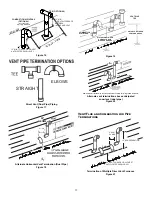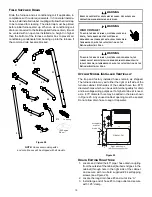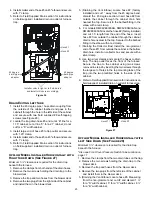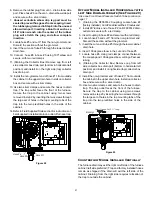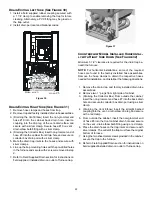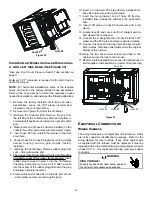
11
Recommended Installation Positions
*MEC96 models may be installed upflow or horizontally with
left or right side down. *CEC96 models may be installed down
flow or horizontally with left or right side down. Do not install this
furnace on its back. For
upright upflow
furnaces, return air
ductwork may be attached to the side panel(s) and/or base
-
pan. For
horizontal upflow
furnaces, return air ductwork must
be attached to the basepan. For both
upright or horizontal
counterflow
furnaces
,
return ductwork must be attached to
the basepan (top end of the blower compartment).
NOTE:
Ductwork must never be attached to the back of the furnace.
Refer to “Recommended Installation Positions” figure for
appropriate installation positions, ductwork connections, and
resulting airflow arrangements.
Horizontal Applications
& Considerations
When installing a furnace horizontally, additional consider
-
ation must be given to the following:
Furnace Suspension
If suspending the furnace from rafters or joists, use 3/8”
threaded rod and 2”x2”x1/8” angle iron as shown in the
following diagram. The length of rod will depend on the
application and the clearances necessary.
If the furnace is installed in a crawl space it must be sus
-
pended from the floor joist or supported by a concrete pad.
Never install the furnace on the ground or allow it to be
exposed to water.
2" 2" 3/8"
ANGLE
IRON
(3
PLACES
)
X X
Figure 3
Front Cover Pressure Switch Tube
Location
When a furnace is installed horizontally with left side down,
the front cover pressure switch tube must be re-located to
he lower port of the collector box cover.
1. Remove tube from front cover pressure switch and
collector box cover.
2. Remove rubber plug from bottom collector box port and
install on top of collector box port.
3. Locate 24’’ x 1/4’’ tube in bag assembly.
4. Install one end on front cover pressure switch.
5. Route tube to lower port on collector box cover and cut
off excess tubing.
Drain Trap and Lines
In horizontal applications the condensate drain trap is secured
to the furnace side panel, suspending it below the furnace. A
minimum clearance of 5.5” below the furnace must be provid
-
ed for the drain trap. Additionally, the appropriate downward
piping slope must be maintained from the drain trap to the
drain location. Refer to
Condensate Drain Trap and Lines
for
further details. If the drain trap and drain line will be exposed
to temperatures near or below freezing, adequate measures
must be taken to prevent condensate from freezing.
Horizontal Furnace Leveling
Leveling ensures proper condensate drainage from the heat
exchanger. For proper flue pipe drainage, the furnace must
be level lengthwise from end to end. The furnace should have
a slight tilt from back to front with the access doors downhill
from the back panel approximately 1/2 to 3/4 inches. The
slight tilt allows the heat exchanger condensate, generated
in the recuperator coil, to flow forward to the recuperator coil
front cover.
Alternate Electrical and Gas Line Con-
nections
This furnace has provisions allowing for electrical and gas
line connections through either side panel. In horizontal
applications the connections can be made either through the
“top” or “bottom” of the furnace.
Drain Pan
A drain pan must be provided if the furnace is installed above
a conditioned area. The drain pan must cover the entire area
under the furnace (and air conditioning coil if applicable).
Freeze Protection
Refer to
Horizontal Applications and Conditions - Drain Trap
and Lines.
Propane Gas/High Altitude
Installations
WARNING
P
OSSIBLE
PROPERTY
DAMAGE
,
PERSONAL
INJURY
OR
DEATH
MAY
OCCUR
IF
THE
CORRECT
CONVERSION
KITS
ARE
NOT
INSTALLED
. T
HE
APPROPRIATE
KITS
MUST
BE
APPLIED
TO
ENSURE
SAFE
AND
PROPER
FURNACE
OPERATION
. A
LL
CONVERSIONS
MUST
BE
PERFORMED
BY
A
QUALIFIED
INSTALLER
OR
SERVICE
AGENCY
.
This furnace is shipped from the factory configured for natural
gas at standard altitude. Propane gas installations require
an orifice and spring change to compensate for the energy
content difference between natural and propane gas.


